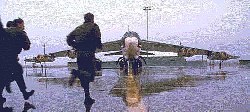

Page 2
2.2: The German Problem
As the end of February approached it became apparent that the Soviet Union was getting ready to take some sort of major action somewhere in Europe. The West Germans found this to be disquieting to say the least. Some were even calling for a full mobilization. Through the West German government demurred on that they did consider offering military help to Poland, but would do so only if the rest of NATO was willing to back them up. The issue was very divisive among the members of the Atlantic Alliance. Generally Germany and Britain were the most hawkish (with the Germans seeing NATO troop deployments to Poland as the ultimate 'forward defense'). Prime Minister Thatcher proclaimed in the House of Commons that this might be the only chance this generation to break up the Warsaw Pact.
2.3: Day One - Operation Central RunThe Soviets, hearing alarming and conflicting reports out of Germany, and seeing that the Americans faced a serious distraction seriously considered ordering their tank armies to 'go west until you hit the English channel.' However cooler heads prevailed. It was, however, decided to call up 20 Category B reserve Divisions to readiness. The Polish Operation was set to go ahead on February 1st.
At 8PM on January 31st 12 B-52D Bombers left their bases at Diego Garcia. These were the first combat sorties of Operation Central Run. At 12AM on February 1st F-14 Tomcats took to the skies over Iran, knocking down the Iranian F-4's and F-14's sent up against them. Within the hour the C-141's and C-5's carrying the 82nd Airborne were entering a secure air corridor. The US Navy approached Bandar Abbas and fired a barrage of Harpoon missiles at the ships in port. After which they closed on the port and began to flatten the waterfront with naval gunfire. B-52's and A-6's pounded Iranian Army positions all day long.
2.4: Day One - Invasion of PolandF-4 Phantom's flying from the US Carriers were used to attack Iranian Airfields and fixed air defense sites. At 6AM in the morning the 82nd Airborne was dropped around the complex at Shiraz. The initial stages of the operation came as a total surprise and came up almost without losses (an F-4 and 2 A-7's were shot down). However the fighting at Shiraz was hard and long, if with few (American) casualties. The Iranian Islamic Revolutionary Guard units which had moved in and around the complex fought to the death against the Americans. Colonel Douglas Jefferson, commander of the 1/71st Airborne gained some minor fame when his unit mis-dropped and fought its way to the scene of battle with him in the lead.
The Polish, despite a lack of Western help, proved that they weren't going to be easy right from the start. An attempt by Soviet Commandos to capture the new Polish Government failed utterly. They found their offices burned and abandoned. The initial Soviet attack faced, not the conventional military resistance expected, but fierce guerrilla attacks. The best units of the Polish Army were used in surprise attacks against the Soviet forces considered most vulnerable. Most ingenious was the Polish use of their Air Force (their own and those seized from the Soviets). The Soviets had expected the Polish to use their air power to conduct a stand up fight. Again the Polish surprised the Soviets.
2.5: Hot Line/Hot SeatThey dispersed their aircraft (even at the expense of much of their refit and repair capacity) and used them in brilliant and unconventional attacks still studied by many Third World Air Forces. Six MiG-23 fighter-bombers were used to emulate a group of Soviet fighters. They flew into the GDR, pretending to be Soviet Aircraft, and then bombed Soviet fuel depots. They left fighters in pairs on long stretches of highway, and then scrambled them at Soviet aircraft. By the end of Day One the Soviets (following a liberal use of their Guards Air Rifles divisions) about ¼ of Poland, including Warsaw, which was taken almost without resistance by a massive air drop. There were nearly 5000 Soviet dead and perhaps as many as 10,000 Polish dead (the Polish had used their elite Army units to blunt the Armored advance on Gdansk.
With both the United States and the Soviet Union commencing major military operations on the same day the world flew into a frenzy of activity, political and military. Most important were the hotline consultations between Moscow and Washington. It was generally agreed that both were willing to, given the present situation, accept the actions of the other. It was further agreed that neither side would, no matter the duration of the operations, comment on, or impede the operations of the other. In the United States and the Soviet Union more hawkish elements of both governments were bitterly disappointed. They felt that they had been let down severely. In the United States, the far left, led by Ted Kennedy, denounced the American action against Iran, especially the US Navy bombardment of Bandar Abbas. Kennedy announced that he would challenge Carter for the US Presidential nomination in 1980.

